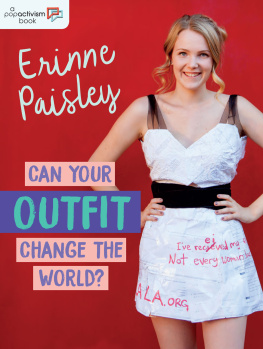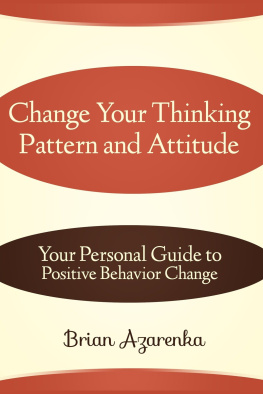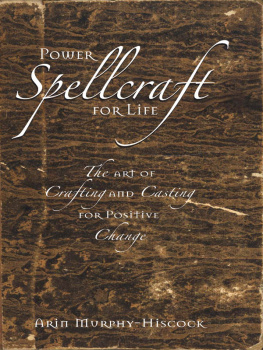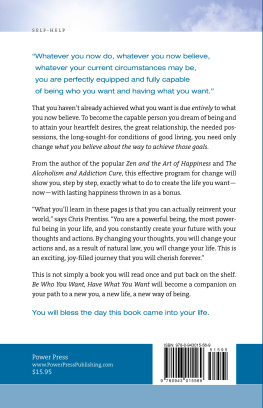acknowledgments
W riting a book about self-discovery requires that I thank all the people who helped me on my own path of learning and exploring. Id like to thank the teachers who opened my eyes and my heart to so much over the yearsespecially Patricia Moreno, who inspired me on the path of gratitude and mindfulness. I want to express my deep gratitude to my team at Simon & Schuster, Jen Bergstrom and Trish Boczkowski, for their encouragement and belief in me, and Elana Cohen, for keeping us all on track, my agent, Farley Chase, for his open heart, my co-author, Savannah Ashour, for her patience and wisdom, and my friends, designer Rolando Santana, for his wonderful work and talent, makeup artist Amanda Thesen, for her expertise, and Andrea Mitchell, who was my guardian angel on this project from the very start. I want to thank all my friends who love and support me unconditionally... you know who you are! And finally, I want to thank my John, who loves me like no one else ever has, and my family, especially my mom, who has taught me everything I know about style and fashion, and most important, how to discover and embrace who you really are.

GEORGE BRESCIA is a top-tier New York Citybased image consultant and the man behind George B Style. He has worked with fashion leaders including Ralph Lauren, Donna Karan, and Tommy Hilfiger, and the fashion directors of Bloomingdales, Bergdorf Goodman, and Lord & Taylor. Meet George Brescia on Facebook, follow him on Twitter, and visit www.georgebstyle.com.
FOR MORE ON THIS AUTHOR: authors.simonandschuster.com/George-Brescia
MEET THE AUTHORS, WATCH VIDEOS AND MORE AT
SimonandSchuster.com
 Facebook.com/GalleryBooks
Facebook.com/GalleryBooks
 @GalleryBooks
@GalleryBooks
chapter 1
the secret language of clothing
learning to read your wardrobe
Style is a simple way of saying complicated things.
Jean Cocteau
W hether your starting point is a full-blown style crisis or just a sense that your current wardrobe is in need of improvement, if youve picked up this book, youre looking for change. Maybe clothing has been a lifelong struggle and youve finally decided to tackle the issue head-on. Maybe youre contemplating a career or personal transition that has you anxious to put your best foot forward, but unsure of how to do it. Or maybe youve always wondered what it would be like to have a personal stylist of your very own.
Whatever your reasons, Im glad you are here. Welcome to the world of George B Style!
For me, clothing is nothing but pure fun, but Ive seen firsthand how very much my clients struggle with style, how fraught and emotional and personal and deep this subject can be. Yet so often, style is treated as though its a problem with a simple solution: a formulaic makeover with a side of increased consumption.
The idea that you can simply buy your way to a better closet is highly flawed. While I do believe there are certain core elements every woman needs in a fully functioning wardrobe, it is also my belief that most style problems start on the inside. They start with long-held beliefs about our limitations, whether physical or mental. They start with fearwhether its a fear of being seen, a fear of being ignored, or a fear of change, aging, progress, and responsibility. They start with confusion about their identities and the various roles they play in their lives.
Why is clothing so emotional, and for many of us, so fraught? Well, first off, clothing is what literally keeps us from going naked. It is a second skin, and its proximity to our actual skin cannot help but bring up a wealth of emotions surrounding body image, self-worth, confidence, and identity. In a very real way, it hides our most vulnerable selves.
It is the bridge between our private, interior worlds and the public, external world through which we travel.
It is a shape-shifting cloak with a symbolic power that works in two ways: deeply affecting our sense of self while simultaneously informing the perceptions of strangers, acquaintances, and loved ones alike. Clothing, more than any of our possessions, has the power to define our identity.
Your Style Is Speaking for You
Here is the central truth of this book: Our clothes speak for us before we do.
Countless studies have proven the sway that first impressions have over our perceptions of the people we come into contact with every dayand over their perceptions of us. Within ten seconds of a first meeting, an impression is formed, and an opinion begins to coalesce.
Think about it: In your daily life, how often do you make assumptions about the people you come across? You spot a man in his mid-forties in the checkout line at your neighborhood grocery store. I can guarantee you that in a matter of seconds, you have taken in enough about his clothing, hair, and general appearance to process guesses as to what he does for a living, how much money he makes, how much you might or might not have in common, and maybe even his politics. These guesses go way beyond the difference between a construction worker in paint-spattered work boots and a banker in a manicured Brooks Brothers suitour eyes are extremely discerning, quickly taking in very subtle details. If hes wearing jeans, it doesnt take a professional stylist to make a snap judgment as to what those jeans mean . You do it all the time, whether youre conscious of it or not. Are they beat-up dungarees that have seen their fair share of drywall, or carefully distressed artisan denim with a price tag north of $150? What does the style of the jean, the hair, the shirt, and the shoe say ? Architect or entertainment lawyer? Serious and ambitious, or laid-back and fun-loving? Possible future husband or commitment-phobe with a Peter Pan complex? Your brain is constantly collecting visual clues and arranging them into patternspatterns that turn into assumptions.
And heres the rub: The same thing is happening to you, every time you step outside your home. The outfit you casually threw on in an early morning haze? Its being assessed by strangers and acquaintances alike as a clue to your character, your identity, and your overall appeal.
Thats why I believe that everything we put on our bodies is a statement piece, whether were talking about the ten-year-old sweats and scary flip-flops you threw on for a grocery store run or the drab office uniform you havent tweaked since Designing Women was still on the air.
Youre probably familiar with the concept of the statement piece. The term sprouts up all over the place in fashion magazines and on makeover showsits stylist code for an eye-catching, colorful garment or accessory that defines your entire look in one fell swoop. But if you think about clothing through the lens of that ten-second rule, youll come to realize that there is no such thing as a non-statement piece.
Everything we wear makes some kind of a statement, whether its a dull army-green puffy coat paired with faded black khakis or a great-fitting pair of jeans flanked by a crisp white tee and a classic navy blazer.
Whether we like it or not, we are being seen. Our statement is being deciphered. And the reach of that statement goes far, far beyond the fleeting impression of a stranger on the checkout line.
Learning to Read Your Own Statement
Heres the good news: Your clothing may be speaking volumes, but what it doesnt have is a mind of its own. That is to say, your outfit didnt simply slip off of its hanger and fling itself onto your bodysomebody selected it for you, and that somebody (YOU!) can choose to make different decisions, more educated decisions, more conscious decisions. Better decisions. You have the power to change your statement, and its a change whose effects will ricochet throughout your entire life.











 Facebook.com/GalleryBooks
Facebook.com/GalleryBooks @GalleryBooks
@GalleryBooks